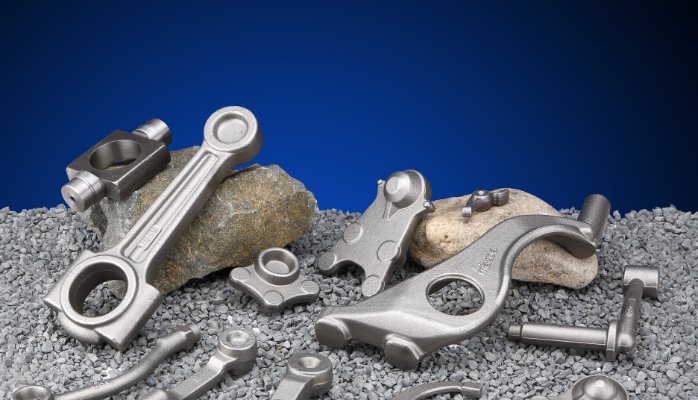Forged product is a manufacturing method that involves pressing metal under high pressure into high-strength products. The procedure is usually (but not always) carried out hot, with the metal being preheated to the proper temperature before being worked. It’s critical to note that the metal used to make forged design components differs from the casting procedure since it has never been melted and poured.
Forging processes the grain structure and improves the physiological properties of metals, enabling grain flow to be oriented in the path of a substantial subsequent case in real-world applications. Strengths, flexibility, and hardness are all substantially better forging than bare metal.
Forging Operations
Generally, forging consists of two operations, depending on the force used.
1.) Drawing Down
Drawing down is a method of elongating the length of a workpiece while reducing the cross-section area. In this method, the workpiece size rises while the number of segments decreases. In addition, a compression force is exerted perpendicular to the long axis. By exerting a tensile tension along the long axis, wires drawn may adjust the length of a material.
2.) Upsetting
Upsetting is the polar opposite of drawing down. The length of the workpiece is reduced while the cross-section area is increased in this procedure. This method applies a compressive force parallel to the long axis in a plane.
Types Of Forging
The following are several types of forging.
According to Temperature
Hot Forging – If a workpiece is heated beyond its melting point and then forced, the process is known as hot forging. Most metals’ recrystallisation temperature is half of their melting temperature.
Warm Forging – If metal is heated to around 40% of its melting point temperature, it is called warm forging. Warm forging is a metal forming method in which a workpiece is heated to a temperature that is higher than its hardening temperature but lower than the temperature at which scales develop.
Cold Forging – At room temperature, cold forging is carried out. Among all forged methods, this one produces the best mechanical qualities. It is a technique that occurs at or near room temperature, as opposed to higher temperatures like hot and warm forging. It is accomplished by simply placing the workpiece between two dies and pressing the dies until the metal takes on the form of the dies.
According to Dies’ Arrangements
Open Die Forging – Another term for open-die forging is Smith Forging. A hammer strikes metal on a static anvil, changing its form. In this forged procedure, the steel is never completely caught in the dies, letting it flow until it comes into contact with the dice. The operation is responsible for orienting and arranging the metal in order to get the desired final shape. For specialised procedures, flat dies are utilised, with some having mainly shaped surfaces. Simple and oversized pieces, as well as bespoke metal components, are appropriate for open-die forging.
Closed Die Forging – It is also known as impression-die forged. It is the process of pounding steel against an anvil after being pushed into a die. A hammer is used to strike the metals, causing them to flow and fill the die cavities. On a millisecond scale, the hammer is designed to produce many contact points with the metal. Excess metal is driven out of the die cavities, causing the flash. The flash outperforms the metals in the dies since it cools faster than the rest of the materials. The beat is eliminated after forging.
According to Forging Equipment
Smith forging – The classic process of metal formation is known as smith forging. It is an open die forging technique in which the work item is set on a fixed anvil and deformed by a hammer. Manual or power hammers are used to apply the force.
Drop Forging – Closed impression dies are used for drop forging. An automated hammer used a dropping motion to provide the force in a succession of blows. A rapidly applied force is employed in this kind.
Press Forging – Press forging is similar to drop forging, but it uses a power drill to continuously pressure the metal. This procedure lengthens the workpiece while reducing its cross-section.
Machine Forging – Machine forging is an upsetting technique that expands the cross-section of the work item while decreasing the length.
Advantages and Disadvantages
The following are the advantages and disadvantages of forged products.
Advantages
1) In comparison to casting, forging produces a more durable product.
2) Forged products have a greater fatigue strength and creep resistance.
3) The mechanical qualities of the forged product are superior.
4) Low-cost operations
5) This procedure does not need the use of a skilled operator.
6) This method may produce a wide range of forms.
Disadvantages
1) Large forged presses have a higher starting cost.
2) In hot forging, a secondary finishing procedure is necessary.
3) It is unable to create complicated forms.
4) Because of the size of the press, the size is restricted.
4) Brittle steel cannot be forged.
Forged products are more cost-effective because of their inherent more excellent dependability, enhanced tolerance capabilities, and the increased efficiency with which forgings may be machined and subsequently processed using automated processes. Forged design components allow for designs that can withstand the most extreme loads and pressures. The variety of qualities possible in forgings has been substantially expanded because of recent developments in forging technology.

